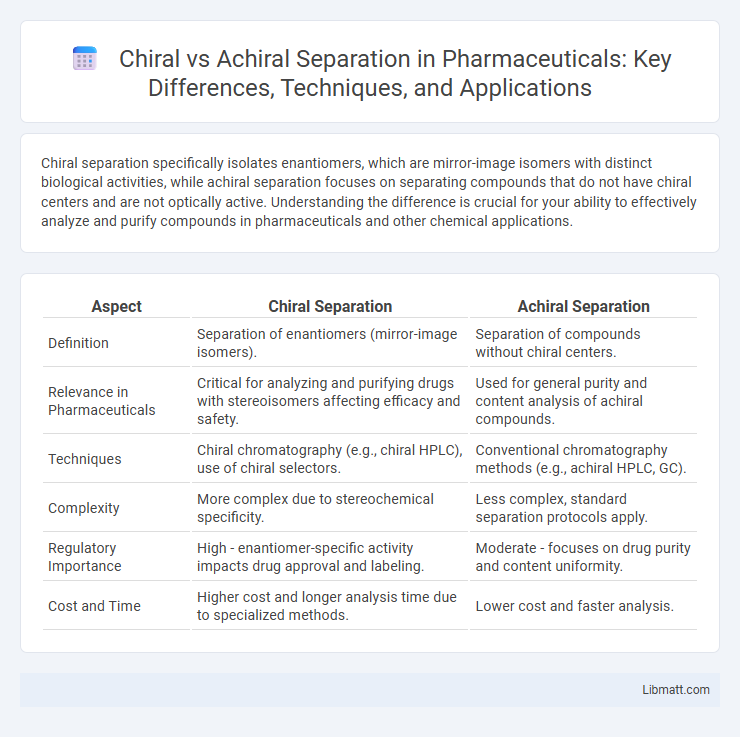Chiral separation specifically isolates enantiomers, which are mirror-image isomers with distinct biological activities, while achiral separation focuses on separating compounds that do not have chiral centers and are not optically active. Understanding the difference is crucial for your ability to effectively analyze and purify compounds in pharmaceuticals and other chemical applications.
Table of Comparison
| Aspect | Chiral Separation | Achiral Separation |
|---|---|---|
| Definition | Separation of enantiomers (mirror-image isomers). | Separation of compounds without chiral centers. |
| Relevance in Pharmaceuticals | Critical for analyzing and purifying drugs with stereoisomers affecting efficacy and safety. | Used for general purity and content analysis of achiral compounds. |
| Techniques | Chiral chromatography (e.g., chiral HPLC), use of chiral selectors. | Conventional chromatography methods (e.g., achiral HPLC, GC). |
| Complexity | More complex due to stereochemical specificity. | Less complex, standard separation protocols apply. |
| Regulatory Importance | High - enantiomer-specific activity impacts drug approval and labeling. | Moderate - focuses on drug purity and content uniformity. |
| Cost and Time | Higher cost and longer analysis time due to specialized methods. | Lower cost and faster analysis. |
Introduction to Chiral and Achiral Separation
Chiral separation involves the selective isolation of enantiomers, molecules that are non-superimposable mirror images, crucial in pharmaceuticals for efficacy and safety. Achiral separation, on the other hand, separates compounds without chirality differences, focusing on physical or chemical properties like polarity, size, or charge. Advanced chromatographic techniques such as chiral HPLC and achiral normal-phase or reversed-phase chromatography enable precise differentiation and purification based on molecular symmetry.
Understanding Chirality in Chemistry
Chiral separation techniques specifically target molecules that exist as non-superimposable mirror images, known as enantiomers, which differ in properties like optical activity and biological interactions. Achiral separation methods separate compounds based on differences in physical or chemical properties without considering molecular handedness. Understanding chirality in chemistry is essential for optimizing Your separation strategy, as enantiomers often exhibit distinct pharmacological effects and metabolic pathways.
Principles of Chiral Separation
Chiral separation relies on the differential interaction between enantiomers and a chiral stationary phase or chiral selector, exploiting their unique spatial configurations to achieve selective retention. Unlike achiral separation, which depends primarily on differences in physicochemical properties such as polarity or molecular size, chiral separation specifically targets the stereochemical differences between mirror-image molecules. Your understanding of these principles is crucial for applications in pharmaceuticals, where enantiomer purity directly impacts drug efficacy and safety.
Principles of Achiral Separation
Achiral separation relies on differences in physical or chemical properties such as polarity, molecular size, or boiling point to separate components within a mixture. Techniques like gas chromatography, reverse-phase liquid chromatography, and size-exclusion chromatography exploit these variations to achieve effective separation without relying on stereochemistry. Understanding interactions between analytes and stationary phases, including hydrophobicity and molecular weight, is crucial for optimizing achiral separation methods.
Techniques Used in Chiral Separation
Chiral separation techniques primarily involve chromatographic methods such as high-performance liquid chromatography (HPLC) with chiral stationary phases (CSPs), capillary electrophoresis (CE) using chiral selectors, and supercritical fluid chromatography (SFC) that offers high efficiency in enantiomer resolution. These methods exploit the stereochemical differences between enantiomers by using chiral selectors like cyclodextrins, polysaccharides, or proteins to achieve selective binding and separation. In contrast, achiral separation techniques rely on differences in physicochemical properties such as polarity or size without the need for chiral recognition elements.
Methods Applied for Achiral Separation
Achiral separation primarily relies on methods such as normal phase chromatography, reversed-phase chromatography, and size exclusion chromatography, which separate compounds based on differences in polarity, hydrophobicity, or molecular size without considering stereochemistry. Techniques like gas chromatography and liquid chromatography under non-chiral stationary phases are commonly used to isolate and analyze achiral compounds efficiently. These methods optimize separation through variations in mobile phase composition, temperature, and stationary phase characteristics to achieve high resolution and purity in achiral mixtures.
Key Differences Between Chiral and Achiral Separation
Chiral separation targets molecules that exist as non-superimposable mirror images called enantiomers, whereas achiral separation deals with compounds lacking chirality. The key difference lies in the methods used: chiral separation often employs specialized chiral stationary phases or chiral selectors to differentiate enantiomers, while achiral separation relies on conventional techniques such as size exclusion or polarity-based chromatography. Your choice between these techniques depends on the need to resolve stereoisomers or separate compounds based purely on physical or chemical properties.
Applications in Pharmaceuticals and Industry
Chiral separation is crucial in pharmaceuticals for isolating enantiomers, which often have distinct biological activities and pharmacokinetics, ensuring drug safety and efficacy. Achiral separation is widely applied in industrial processes for purifying non-chiral compounds, such as solvents, polymers, and intermediates, optimizing product quality and manufacturing efficiency. Techniques like chiral chromatography and achiral HPLC are tailored to specific molecular properties, impacting drug development and large-scale industrial production.
Challenges in Chiral and Achiral Separations
Chiral separation presents challenges due to the need to distinguish enantiomers, which have identical physical and chemical properties except optical activity, requiring highly specific chiral selectors or stationary phases to achieve resolution. Achiral separation, while generally more straightforward, faces challenges in separating compounds with very similar polarity or molecular weight, necessitating precise control of parameters like mobile phase composition and column selection. Both methods demand rigorous optimization to enhance selectivity, resolution, and reproducibility in complex sample matrices.
Future Trends in Separation Science
Future trends in separation science emphasize advanced chiral separation techniques using high-resolution chromatography and novel stationary phases to improve enantiomeric purity crucial for pharmaceuticals. Achiral separation continues evolving with enhanced selectivity and speed driven by innovations in materials like metal-organic frameworks and microfluidics. Your ability to achieve precise molecular differentiation will benefit from integrating artificial intelligence and automation into both chiral and achiral separation processes.
Chiral separation vs Achiral separation Infographic

 libmatt.com
libmatt.com